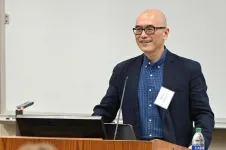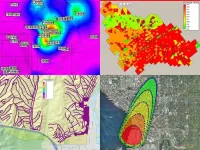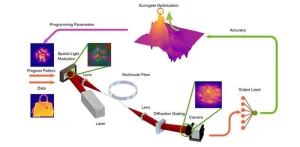(Press-News.org) From the impacts on the environment and climate to transforming land cover and habitats, urban growth is driving global change. Urban areas contribute up to 75% of global greenhouse gas emissions. By 2050, urban areas globally will either double or triple, and the raw materials needed to build future cities is more than the world can sustainably provide.
Yet, the impacts of cities on Earth systems are not factored into policy and planning among international agencies and that needs to change, says Karen Seto, Frederick C. Hixon Professor of Geography and Urbanization Science at the Yale School of the Environment. In a commentary recently published in Science, Seto and an international group of leading scientists called for the creation of a new urban advisory system.
Noting that more than half the world’s population live in urban areas and worldwide urban land expansion is one of the key drivers of habitat and biodiversity loss, the authors point to myriad ways that urban expansion affects global systems by putting pressure on resources, ecosystems, and the climate and emphasize the importance of scientific research in local and global decision making.
The authors advocate for the creation of an urban science panel that could support the United Nations as well as multilateral policy-making groups.
“This is about ensuring that world leaders and policymakers have the information that they need at their fingertips to design a world that reflects and responds to humanity’s urban future,” the authors wrote.
Seto, director of the Hixon Center for Urban Sustainability, is one of the world’s foremost experts on the global impacts of urbanization. She was the coordinating lead author for two U.N. climate assessment reports, the IPCC 5th (2014) and 6th (2022), and co-led the chapters on how cities can mitigate climate change. She pioneered the use of satellite remote sensing analysis to study land change and urban growth and has focused her research on how cities can play a significant role in mitigating climate change through design, low-cost energy initiatives, and sustainable transportation and building materials. To accomplish this, a coordinated effort is needed to transform existing urban science into practical guidance for international policy design for urban areas, Seto and co-authors Jessica Espey, Michael Keith, Susan Parnell, and Tim Schwanen noted.
“Cities are the nucleus from which humanities’ impact on all Earth systems can be observed. One would thus expect urban dynamics and impacts to be at the top of global governance agendas,” they wrote in the commentary.
There are existing bodies that work on cities and sustainable development goals within the U.N. and regulatory bodies within states, cities, and towns that work at the local level, but the authors stress that their focus is on singular issues or local regulations rather than at the planetary level.
“Although these existing parallel processes are important, they are failing to bring the seismic effects of urban change on the world to the attention of policy makers,” they contend.
They recommend the creation of an urban science advisory panel composed of scientists who have a clear political mandate and a requirement to submit findings to the U.N. Such a group could be rooted in an entity affiliated with the office of the U.N. secretary general or as part of the U.N.’s Multi-Stakeholder Forum on Science, Technology and Innovation for Sustainable Development Goals.
“Whatever mechanism is used, it is well past time for evidence-based dialogue on the planet-wide effects of urbanization at the highest levels of international government. Our planet’s future is an urban future, and our systems of international administration must reflect that,” the authors state.
END
Achieving sustainable urban growth on a global scale
2024-01-25
ELSE PRESS RELEASES FROM THIS DATE:
Illinois Tech professor Chun Liu honored as 2024 Fellow by American Mathematical Society
2024-01-25
CHICAGO—January 25, 2024—Illinois Institute of Technology (Illinois Tech) Professor Chun Liu has been elected a 2024 fellow of the American Mathematical Society (AMS)—one of just 40 mathematical scientists to be honored this year for his contribution to mathematics.
“It’s nice to be recognized by my colleagues, but this also gives visibility for the whole department and Illinois Tech,” says Liu, chair of the Department of Applied Mathematics. “It’s great recognition for the mathematics research that’s going on here at Illinois Tech.”
Liu’s research includes partial differential ...
Chats with AI shift attitudes on climate change, Black Lives Matter
2024-01-25
MADISON — People who were more skeptical of human-caused climate change or the Black Lives Matter movement who took part in conversation with a popular AI chatbot were disappointed with the experience but left the conversation more supportive of the scientific consensus on climate change or BLM. This is according to researchers studying how these chatbots handle interactions from people with different cultural backgrounds.
Savvy humans can adjust to their conversation partners’ political leanings and cultural expectations to make sure they’re understood, but more and more often, humans find themselves in ...
PNNL Software Technology wins FLC Award
2024-01-25
RICHLAND, Wash.—Visual Sample Plan (VSP), a free software tool developed at the Department of Energy's Pacific Northwest National Laboratory (PNNL) that boosts statistics-based planning, has been recognized with a 2024 Federal Laboratory Consortium (FLC) Award.
The FLC represents over 300 federal laboratories, agencies, and research centers. The annual FLC awards program recognizes agencies for their contributions to technology transfer, which turns innovative research into impactful products and services.
Judges bestowed ...
Programming light propagation creates highly efficient neural networks
2024-01-25
Current artificial intelligence models utilize billions of trainable parameters to achieve challenging tasks. However, this large number of parameters comes with a hefty cost. Training and deploying these huge models require immense memory space and computing capability that can only be provided by hangar-sized data centers in processes that consume energy equivalent to the electricity needs of midsized cities. The research community is presently making efforts to rethink both the related computing hardware and the machine learning algorithms to sustainably keep the development of artificial intelligence at its current pace.
Optical implementation ...
Advincula earns prestigious NAI fellow honor
2024-01-25
Rigoberto “Gobet” Advincula has been awarded one of the highest honors of his profession.
Advincula, the University of Tennessee-Oak Ridge National Laboratory Governor’s Chair of Advanced and Nanostructured Materials, has been elected National Academy of Inventors (NAI) Fellow.
Advincula is a leader in the polymer field with inventions and many publications in polymer nanocomposites, graphene nanomaterials, polymer layered films, and coatings. He has been granted 14 US patents and has 21 published filings related to graphene nanomaterials, solid-state device fabrication, smart coatings and films, ...
Sweat-analyzing temporary tattoo research funded in NSF grant to UMass Amherst researcher
2024-01-25
AMHERST – University of Massachusetts Amherst researchers have received an award to develop a new type of sweat monitor that can be applied to the skin just like a temporary tattoo and assess the molecules present, such as cortisol. The tattoos will ultimately give individuals better insight into their health and serve as a tool for researchers to discover new early indications of diseases.
“There are a lot of vital biomolecules that are present in sweat that we need to measure to really understand overall human performance and correlation to different ...
Simulations show how HIV sneaks into the nucleus of the cell
2024-01-25
Because viruses have to hijack someone else’s cell to replicate, they’ve gotten very good at it—inventing all sorts of tricks.
A new study from two University of Chicago scientists has revealed how HIV squirms its way into the nucleus as it invades a cell.
According to their models, the HIV capsid, which is cone-shaped, points its smaller end into the pores of the nucleus and then ratchets itself in. Once the pore is open enough, the capsid is elastic enough to squeeze through. Importantly, the scientists ...
White House rule dramatically deregulated wetlands, streams and drinking water
2024-01-25
The 1972 Clean Water Act protects the "waters of the United States" but does not precisely define which streams and wetlands this phrase covers, leaving it to presidential administrations, regulators, and courts to decide. As a result, the exact coverage of Clean Water Act rules is difficult to estimate.
New research led by a team at the University of California, Berkeley, used machine learning to more accurately predict which waterways are protected by the Act. The analysis found that a 2020 Trump administration rule removed Clean Water Act ...
How an ant invasion led to lions eating fewer zebra in a Kenyan ecosystem
2024-01-25
The invasion of non-native species can sometimes lead to large and unexpected ecosystem shifts, as Douglas Kamaru and colleagues demonstrate in a unique, careful study that traces the links between big-headed ants, acacia trees, elephants, lions, zebras, and buffalo at a Kenyan conservancy. The invasive big-headed ant species disrupted a mutualism between native ants and the region’s thorny acacia trees, in which the native ants protected the trees from grazers in exchange for a place to live. Through a combination of observations, experimental plots, and animal tracking at Ol Pejeta Conservancy, Kamaru et al. followed the ecosystem chain reaction prompted by this disruption. ...
Total organic carbon concentrations measured over Canadian oil sands reveal huge underestimate of emissions
2024-01-25
New measurements of total gaseous organic carbon concentrations in the air over the Athabasca oil sands in Canada suggest that traditional methods of estimating this pollution can severely underestimate emissions, according to an analysis by Megan He and colleagues. Using aircraft-based measurements, He et al. conclude that the total gaseous organic carbon emissions from oil sands operations exceed industry-reported values by 1900% to over 6300% across the studied facilities. “Measured facility-wide emissions represented approximately 1% of extracted petroleum, resulting in total organic ...




